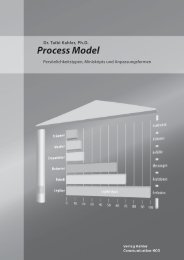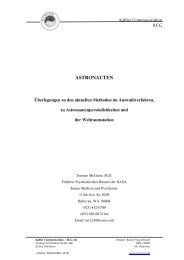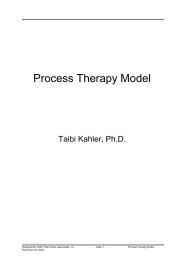Process Therapy Model - bei Kahler Communication
Process Therapy Model - bei Kahler Communication
Process Therapy Model - bei Kahler Communication
Create successful ePaper yourself
Turn your PDF publications into a flip-book with our unique Google optimized e-Paper software.
• Classic defense mechanisms are hypothesized.<br />
• Examples of the second-by-second Driver words are presented 32 , and the behavioral life<br />
position. Frank Ernst 33 had identified four life positions. Drivers indicate that there is<br />
another behavioral life position: OK if… [I believe there is only one existential life<br />
position: I’m OK - - You’re OK. The other four are only behavioral]. 34<br />
• 1979 – 1982 research identified a significant Failure Mechanism 35 for each Personality<br />
Type in 2 nd degree distress.<br />
• The 1970 – 1972 and 1979 – 1982 research studies identified Warning Signals 36 for each<br />
Personality Type in 2 nd degree distress.<br />
• At 2 nd degree distress there are two possible roles in Steve Karpman’s Drama Triangle 37<br />
that can be observed: Persecutor and Victim (of/to Persecutor). The 1970 – 1972 and<br />
1979 – 1982 research studies 38 identified the Role for each Personality Type in 2 nd degree<br />
distress.<br />
• Two behavioral Life Positions of the four identified originally by Frank Ernst in his O.K.<br />
Corral can be observed at 2 nd degree distress: I’m Not OK - - You’re OK or I’m OK - -<br />
You’re Not OK. The 1970 – 1972 and 1979 – 1982 research studies 39 identified the<br />
behavioral Life Position for each Personality Type in 2 nd degree distress.<br />
• Three possible ego states are observable at 2 nd degree distress. Eric Berne discovered<br />
ego states, identifying them as Parent, Adult, and Child, and classifying them as existing<br />
in structure and function. 40 In 1970 I began to identify the behavioral cues - - words,<br />
tones, gestures, posture, and facial expressions - - for the positive and negative parts of<br />
the functional ego states. These observations were published in the miniscript article in<br />
1974, in which I separate the functional Parent into –CP, +CP, - NP, and +NP, and the<br />
functional Child into +AC, FC –AC (subdivided into VC and three types of –AC). 41 The<br />
1970 – 1972 and 1979 – 1982 research studies identified the three ego states involved at<br />
2 nd degree distress - - VC, -AC, and –CP - - and the one that correlates with each<br />
Personality Type at 2 nd degree distress. 42 The intervention strategy when presented with<br />
one of these three ego states is: determine which personality phase is involved, and then<br />
offer the psychological need of that phase type to the client (transactions and perceptions<br />
alone are not “strong” enough).<br />
• In 1966 Eric Berne defined rackets as “the sexualization and transactional exploitation of<br />
unpleasant feelings.” 43 In the Miniscript article I showed that rackets are feelings that<br />
exist only at positions 2 and 3, 44 which are combined into 2 nd degree distress in PTM. 1 st<br />
degree distress is Driver level, and has no feelings involved. 3 rd degree distress does not<br />
involve transactions, so no rackets are there, only collected stamps. This leaves 2 nd<br />
degree distress which is activated by a shift form –NP Driver sequences (introjected or<br />
projected) to –CP injunctions (introjected or projected). I further explained this in my<br />
1975 arcticle, “Structural Analysis: A Focus on Stroke Rationale, A Parent Continuum<br />
and Egograms.” 45 Results from the 1970 – 1972 and 1979 – 1982 studies identify the<br />
rackets most correlated with each Personality Type in 2 nd degree distress. 46<br />
• In 1947 Eric Berne 47 defined games as having an orderly series of transactions, an ulterior<br />
aspect, and a payoff. By 1970 Berne 48 had developed “Formula G," which is<br />
C+G=R→S→X→P. In the 1974 miniscript article 49 and in depth in my 1978 book,<br />
Transactional Analysis Revisited, 50 I diagrammed these moves in games using the<br />
miniscript, showing that all games start with a Driver at the Con and Gimmick level, and<br />
progress to [2 nd Degree] at the Response, Switch, Crossup, and Payoff, with Payoff<br />
possibly lingering as a stamp at 3 rd degree distress.<br />
©September 2004 Taibi <strong>Kahler</strong> Associates, Inc. Page 12 The <strong>Process</strong> <strong>Therapy</strong> <strong>Model</strong> ©<br />
November 28, 2005





